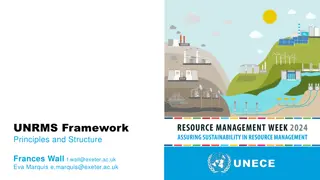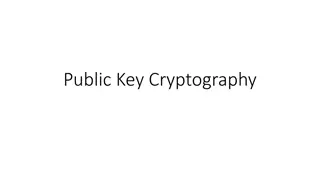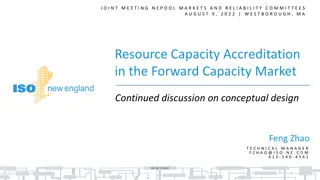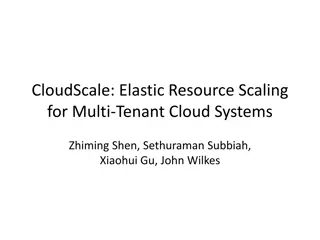Efficient Resource Mobilization and Management Strategies by Dr. Abraham Maliet Mamer
This content discusses efficient resource mobilization and management strategies, emphasizing the importance of understanding the typical cycle of resource regime, defining resources, identifying resources, and mobilizing resources effectively. It provides insights into resource allocation methodolo
1 views • 12 slides
Importance of Public Sector Auditing in Enhancing Accountability and Governance
The Auditor-General of South Africa plays a critical role in strengthening democracy through auditing public sector institutions. Public sector auditing ensures compliance, performance evaluation, and governance transparency, ultimately building public confidence. Key stakeholders include government
1 views • 11 slides
Comprehensive Overview of UNRMS Framework and Principles
UNRMS (UN Resource Management System) aims to promote sustainable resource management globally through innovative frameworks and principles. It encompasses various natural resources and supports sustainability at different scales. Stakeholders can use it to assess projects against environmental, soc
5 views • 10 slides
India Alliance Clinical & Public Health fellowship in India
India Alliance Clinical & Public Health fellowship in India\n\nIndia Alliance Clinical and Public Health Research Fellowships are for Health researchers with an MD, MS, MPH, or an equivalent clinical or public health degree, who can apply for the DBT\/Wellcome Trust India Alliance Clinical and Publi
0 views • 5 slides
Understanding Knowledge as a Valuable Resource in Progress and Governance
Explore the concept of knowledge as a resource for progress and governance through insightful perspectives from Jeremy Sheff, Isaiah Berlin, Arturo Espinoza, and Thomas Jefferson. Delve into the ideas of nonexcludability and nonrivalrousness in the context of public goods and resource allocation eff
0 views • 14 slides
Introduction to Public Key Cryptography
Public key cryptography, exemplified by algorithms like Diffie-Hellman and RSA, revolutionizes secure communication by allowing users to encrypt messages with public keys known to all and decrypt them with private keys known only to the intended recipient. This advanced encryption method ensures sec
1 views • 44 slides
Comparative Analysis of Municipal Services in Public Sector Evolution
Explore the evolution and role of public services in the municipal sector through a comparative analysis presented in a block seminar by Prof. István Hoffman. Delve into the general theory of public services, the traditional and changing approaches of public administration, and government expenditu
0 views • 74 slides
Forward Capacity Market Resource Capacity Accreditation Discussion
Discussion on improvements to resource capacity accreditation in the Forward Capacity Market to support a reliable, clean-energy transition by accrediting resource contributions effectively as the resource mix evolves. Covers conceptual design, stakeholder schedule, and review of proposed enhancemen
0 views • 61 slides
Enhancing Public Health Workforce for COVID-19 Response Grant Program
This cooperative agreement aims to strengthen public health departments by expanding staff, hiring school nurses, and developing public health leaders. It includes major goals like creating a Public Health AmeriCorps and modernizing the public health workforce. The grant terms specify funding distri
1 views • 17 slides
Population Resource Regions and Zelinsky's Classification
Geographers have long studied the relationship between population growth and resource adequacy, leading to the concept of Population Resource Regions (PRR) by W. Zelinsky. Zelinsky identified five types of PRR based on population-resource ratios, ranging from Type A with high resource utilization po
0 views • 8 slides
Introduction to Resource Management in Construction Industry
The construction industry operates in a dynamic environment with time, money, and resource constraints. This chapter focuses on resource management, optimization methods, and applications in construction. It covers the definition of resources, types of resources, and the importance of optimization i
2 views • 15 slides
Understanding Judicial Review in Suing Public Authorities
Judicial review is the inherent right of courts to review decision-making processes of public bodies. It allows for challenging and analyzing decisions, granting public law remedies like declaration, certiorari, mandamus, prohibition, and quo warranto. Those adversely affected by public duty actions
0 views • 13 slides
Exploring Public Integrity and Ethics in Civil Service
This module on public integrity and ethics delves into key instruments for strengthening ethical practices in public organizations, challenges faced, analyzing codes of ethics, and managing integrity risks. The agenda includes activities like structured ethical reflection, understanding public value
1 views • 13 slides
Overview of Standard Method of Resource Scheduling for Effective Project Management
Resource Schedule Documents (RSD) prepared using Standard Method of Resource Scheduling 1 (SMRS 1) facilitate efficient allocation, planning, and management of resources. The RSD includes sections detailing employer and contractor responsibilities, material issues, method statements, and charges. SM
0 views • 9 slides
Norway's Oil for Development Program: Addressing the Resource Curse
Norway's Oil for Development program aims to manage petroleum resources responsibly to benefit future generations, transforming the resource curse into a blessing. Established in 2005, the program focuses on capacity development, public finance, and environmental concerns in oil economies. It has sh
0 views • 17 slides
Understanding the Economic Problem: Choices and Resource Allocation
This comprehensive study covers key concepts in economics, such as the economic problem, cost-benefit analysis, resource scarcity, production possibilities, and distribution of resources. It delves into the importance of costs and benefits in decision-making, categorizing them, and identifying varia
0 views • 16 slides
Understanding Public Procurement Processes and the Public Procurement Act of 2007
Public procurement involves the systematic acquisition of goods, works, and services using public funds through a fair and transparent process. The Public Procurement Act of 2007 outlines the procedures for procurement, ensuring value for money, efficiency, and equity. This process aims to instill p
0 views • 37 slides
Understanding Indiana's Open Door Law: Public Access and Governance
The Indiana Open Door Law ensures transparency in public agency actions by requiring open meetings unless exempted. The Public Access Counselor provides guidance on public access laws, emphasizing the importance of public information accessibility. Meetings under the law must be open to the public,
0 views • 17 slides
Understanding the Importance of 4-H Natural Resource Clubs for Youth Development
Exploring the significance of 4-H Natural Resource Clubs through insights from surveys conducted among 4-H members, Extension Educators, and Natural Resource Professionals. The data highlights motivations, barriers, and suggested resources to enhance participation in natural resource projects, empha
0 views • 17 slides
Moving Instructional Tasks to Teacher Resource Link - Richard Woods, Georgia's School Superintendent
Richard Woods, Georgia's School Superintendent, is transitioning ELA and Math instructional tasks for students with significant disabilities from the Resource Board to the Teacher Resource Link (TRL) accessible through SLDS. Science and Social Studies items will soon be available on TRL as well. The
1 views • 12 slides
Understanding the Role of Public Health Practitioners in London's Workforce Development
Public Health Practitioners (PHPs) play a crucial role in implementing and delivering public health services, programs, and interventions. They focus on promoting health and wellbeing within communities, addressing health inequalities, and protecting the public from environmental hazards. Learn abou
0 views • 23 slides
Understanding Public Goods in Higher Education
This text delves into the concept of public goods in higher education, examining the distinctions between public and private forms, the economic and political dimensions, and the normative value of public goods. It discusses the economic definition of public goods, emphasizing their non-rivalrous an
1 views • 18 slides
Zorua: A Holistic Resource Virtualization in GPUs Approach
This paper presents Zorua, a holistic resource virtualization framework for GPUs that aims to reduce the dependence on programmer-specific resource usage, enhance resource efficiency in optimized code, and improve programming ease and performance portability. It addresses key issues such as static a
0 views • 43 slides
Understanding New Jersey's Open Public Meetings Act (OPMA)
This presentation outlines the Open Public Meetings Act (OPMA) in New Jersey, emphasizing the importance of public access to government meetings and decision-making processes. Sen. Byron M. Baer's Sunshine Law ensures transparency and democracy by allowing the public to attend and observe public bod
0 views • 66 slides
Enhancing Public Services through Open Government Partnership in Georgia
The National Agency of State Property in Georgia, in partnership with the Open Government Partnership (OGP) and supported by the United Nations Development Programme (UNDP), has undertaken a project to improve transparency, accountability, and citizen engagement in public services. The 2014-2015 Act
0 views • 9 slides
Ensuring Transparency in Public Governance: The Brown Act and Public Records Act
This content emphasizes the importance of transparency in public governance by discussing key laws such as the Brown Act and Public Records Act. It highlights the necessity for public officials to conduct business transparently, allowing the public to monitor and participate in decision-making proce
0 views • 22 slides
Understanding the Role of Public Opinion in the Political Process
The political process involves the interaction of public opinion, interest groups, and political parties. Public opinion, shaped by factors like media and socialization, influences government actions. This chapter discusses the significance of public opinion, its formation, and measurement through p
0 views • 39 slides
Overview of Public Procurement System in Lithuania
The public procurement system in Lithuania is governed by various laws and regulations, covering different sectors such as concessions, defense/security, utilities, and classical sector. The system includes procedures for different monetary value procurements, including international, simplified, an
0 views • 44 slides
Region IV Public Health Training Center Overview
The Region IV Public Health Training Center (PHTC) is dedicated to strengthening the competence of the public health workforce in HHS Region IV. It provides professional development opportunities for both current and future public health professionals through training programs, field placements, and
0 views • 33 slides
Fair and Efficient Multi-Resource Sharing in Social Networks
This paper explores the concept of fair and efficient multi-resource sharing in social networks, presenting a credit market-based framework for charge-free computing resource sharing. It addresses the challenges of escalating data volumes and the need for collaborative resource allocation strategies
0 views • 21 slides
Human Resource Management Issues in the Public Service: An Analysis
Ministry of Public Service's authority in managing the Public Service under the Public Service Act, 2008, aiming to enhance recruitment, development, and retention of skilled workforce. The paper addresses various issues like recruitment, wage bill management, payroll management, pension management,
0 views • 21 slides
Understanding Public Services in Modern Democracies
Public services play a crucial role in modern democracies, encompassing a wide range of essential services provided by the government to its citizens. These services, whether directly provided or publicly financed, are integral to ensuring equal access and upholding fundamental human rights. Public
0 views • 10 slides
CloudScale: Elastic Resource Scaling for Multi-Tenant Cloud Systems
CloudScale is an automatic resource scaling system designed to meet Service Level Objective (SLO) requirements with minimal resource and energy cost. The architecture involves resource demand prediction, host prediction, error correction, virtual machine scaling, and conflict handling. Module 1 focu
0 views • 37 slides
Evolution of Public Policy: From Seeds Sown in 1940s to Academic Discipline in Social Science
The lives of citizens are shaped by public policies, often unnoticed. The analysis of current public policy in America carries a unique 20th-century essence. Beginning in the 1940s, these policy seeds have profoundly influenced government and academic institutions. By the early 1950s, public policy
0 views • 6 slides
Challenges of Flow Rate Fairness in Network Resource Allocation
Addressing the concept of flow rate fairness in network resource allocation, this content explores its limitations and challenges. Despite being a goal in protocols like TCP, the practicality and enforceability of flow rate fairness are questioned. It highlights the inadequacy of flow rate as a meas
0 views • 15 slides
Enhancing Library Consortium Resource Sharing: NC Cardinal Case Study
Explore the success story of the NC Cardinal Consortium in revolutionizing resource sharing among public libraries. From its formation to significant growth in library systems, learn about the key advantages, statistics, transit numbers, and holds strategies that have led to improved patron services
0 views • 22 slides
Resource Adequacy in Kentucky and the U.S.: Regulatory Insights
Presentation by Kent Chandler, Chairman of the Kentucky Public Service Commission, highlighting the significance of resource adequacy in ensuring reliable electricity supply. The role of regulatory agencies like PSC in reviewing utility investments, integrated resource planning, and the distinction
0 views • 14 slides
IMF Statistics Department - Natural Resources Statistical Tools
IMF Statistics Department has developed two statistical tools, the Revenue Template and National Accounts Template, to help countries analyze government revenues and natural resources in national accounts. These tools are crucial for policymaking in countries heavily reliant on natural resource reve
0 views • 9 slides
Employee Community Resources at UF: Family Resource Coordinator Services
Providing UF employees access to valuable community resources through the Family Resource Coordinator, including discounted services for childcare, housing, health & wellness, transportation, entertainment, campus discounts, food, and more. Additional on-campus resources such as the Field and Fork P
0 views • 6 slides
Enhancing Capacity Planning for Peak Demand and Flexible Resource Requirements
Addressing the challenges in identifying capacity needs for utilities and regions, the discussion covers PowerSimm's approach compared to other modeling tools, resource capability characterization, and regional resource sharing opportunities. The article also reviews comments on NorthWestern's syste
0 views • 17 slides







































